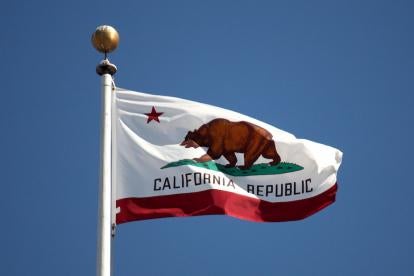California is jumpstarting its planning for offshore wind. Under newly enacted legislation, Assembly Bill No. 525 (“AB 525”), California agencies are now tasked with identifying the state’s offshore wind goals and with developing a strategic plan to address several issues that have affected offshore wind development on the Eastern seaboard, such as port infrastructure and upgrades, transmission bottlenecks, impacts to other ocean users and communities, and permitting challenges.
AB 525 broadly outlines California’s offshore wind strategy and the role of offshore wind in achieving the state’s ambitious clean energy goals.[1] AB 525 is the latest evolution of the California 100 Percent Clean Energy Act of 2018, which requires 100 percent of retail sales of electricity to end-use customers and electricity procured by state agencies to come from eligible renewable energy sources and zero-carbon resources by the end of 2045.[2]
The Role of Offshore Wind in Meeting California’s De-carbonization Goals
Earlier this year, several California agencies published a Joint Agency Report[3] providing an assessment of how the state should approach achieving the goals established by the 100 Percent Clean Energy Act of 2018. Among other conclusions, the portfolio modeling indicated that at least 10,000 MW of offshore wind energy development is needed to achieve the state’s clean energy goals. The report acknowledged that considerable barriers hinder the state’s participation in the burgeoning offshore wind market, including significant transmission upgrade requirements and competing coastal uses limiting the portions of the Outer Continental Shelf (“OCS”) otherwise suitable for offshore wind development. Additionally, the agencies noted that the depth of the OCS off the coast of California would likely require the use of floating offshore wind technologies. While the agencies recognized that floating offshore wind technologies are relatively nascent, the report concluded that the global industry for floating offshore wind technologies is growing quickly and would likely provide significant economic opportunities for the State of California.
AB 525
The momentum from the 2021 Joint Agency Report precipitated AB 525 and its enactment on September 23, 2021. The law has several broad requirements. First, by June 1, 2022 the California Energy Commission (“CEC”) must evaluate and quantify the maximum feasible capacity of offshore wind needed to achieve reliability, ratepayer, employment, and de-carbonization benefits. Based on this data, the Commission must establish offshore wind planning goals for 2030 and 2045 – essentially the CEC’s recommendation for how much offshore wind California will need, considering the state’s need for renewable energy (and the profile of such energy), the economies of scale for offshore floating wind, supply chain development, and the impacts to various resources, industries, and populations.
Second, the CEC is required to submit a preliminary quantitative assessment of the economic benefits of offshore wind, including seaport investments and needed workforce development, by December 31, 2022.
In addition, AB 525 requires the CEC to develop a strategic plan, due by June 30, 2023, prepared in coordination with various federal, state, and local agencies, and other stakeholders, and such plan must:
-
identify suitable federal waters that could support the state’s offshore wind goals;
-
evaluate port facility improvements needed to support the development and deployment of floating offshore wind technologies;
-
assess the transmission investments and upgrades needed, in consultation with the PUC and the California Independent System Operator Corp.;
-
outline a permitting roadmap covering generation and transmission development, including timelines and milestones; and
-
quantify the potential impacts on coastal resources, fisheries, Native American and Indigenous peoples, and national defense, along with strategies for addressing those impacts.
The strategic plan generally will evaluate the foregoing areas to support the state’s offshore wind planning goals for 2030 and 2045.
Federal Leasing Offshore California
California’s passage of AB 525 follows significant movement on the part of the federal government to accelerate offshore wind leasing in the Pacific. In 2018, the Bureau of Ocean Energy Management (“BOEM”) published a Call for Information and Nominations (“Call”) for commercial offshore wind leases on the OCS offshore California.[4] The 2018 Call identified the Humboldt, Morro Bay, and Diablo Canyon call areas for consideration for leasing. In July 2021, BOEM formally designated the Humboldt call area as a Wind Energy Area (“WEA”), and the agency is now preparing an Environmental Assessment of future leasing in this area. That same month, BOEM also issued a Call for East and West extensions to the previously identified Morro Bay call area.[5] BOEM has stated that it intends to conduct a lease sale for WEAs offshore California as early as next year, paving the way for future project development encouraged by AB 525. Notably, the roughly 421,660 acres available between the Humboldt and Morro Bay areas would support only about two-thirds of the 10,000 MW minimum for offshore wind identified in the state’s 2021 Joint Agency Report.[6]
What’s Next?
California’s emerging offshore wind blueprint is familiar: many East Coast states have developed similar strategic plans that have been used to inform each state’s offshore wind development strategy and priorities. Many state plans focus on workforce development and job opportunities, while others focus on climate justice and driving down the cost of electricity. Based on the scope of the strategic plan outlined by AB 525, it appears that California plans to take a holistic approach that seeks to address a broad spectrum of issues. Moreover, the emergence of floating offshore wind technology, and the associated manufacturing and infrastructure needed to support it, present a unique opportunity for California that was not contemplated by many East Coast strategic plans.
Nonetheless, the development of onshore and offshore transmission to support offshore wind is a challenge shared by both coasts. While it is widely recognized that existing approaches to transmission planning have failed to keep up with the need to facilitate the integration of renewable and low-carbon resources, the integration of offshore wind resources presents unique challenges. Due in part to the limited number of viable interconnection points in proximity to any given lease area and the large scale of offshore wind resources, the costs associated with interconnecting offshore wind historically have far exceeded the costs faced by onshore renewable developers and can escalate quickly as the scale of offshore wind development increases. For instance, a recent report sponsored by Americans for a Clean Energy Grid found that the limited quantity of interconnection capacity available along the East Coast meant that the costs of upgrades would increase rapidly from approximately $275/kW for early stage development to over $1,300/kW for later projects.[7]
These challenges have resulted in increasing interest in the development of offshore backbone transmission facilities capable of facilitating the interconnection and delivery of energy from multiple offshore wind projects. For instance, New Jersey and PJM Interconnection, L.L.C. (“PJM”) are in the midst of evaluating proposals to develop an offshore transmission grid that were submitted in response to a solicitation initiated by New Jersey under PJM’s State Agreement Approach to identify transmission solutions to help facilitate the interconnection of offshore wind resources being developed to meet New Jersey’s clean energy goals.
While the State Agreement Approach is a PJM-specific mechanism, the California Independent System Operator (“CAISO”) and the California Public Utilities Commission (“CPUC”) have entered into a memorandum of understanding under which the CPUC develops resource portfolios reflecting California’s clean energy goals to be evaluated through the CAISO’s Transmission Planning Process. Even before AB 525, the CPUC had directed the CAISO to evaluate the costs associated with upgrading transmission to accommodate between 8.3 GW and 21.1 GW of offshore wind through the 2021-2022 transmission planning process, the results of which are expected to be released in March 2022.[8] As California looks to increase its commitment to offshore wind, it will become increasingly important for the CAISO and the CPUC to work closely to ensure that the grid is being planned to take into account the need for new transmission solutions to facilitate offshore wind integration.
AB 525 and the forthcoming strategic plan are important steps in the path to defining how best to leverage California’s tremendous offshore wind resources and remove barriers to the efficient and cost-effective development of these resources to meet California’s renewable energy goals.
[1] Energy: offshore wind generation, Cal. Assemb. B. 525 (2021-2022).
[2] The 100 Percent Clean Energy Act of 2018, 2018 Cal. Legis. Serv. Ch. 312 (S.B. 100).
[3] Cal. Energy Comm’n et al., 2021 SB 100 Joint Agency Report (Mar. 2021).
[4] Commercial Leasing for Wind Power Development on the Outer Continental Shelf Offshore California – Call for Information and Nominations, 83 Fed. Reg. 53096 (Oct. 19, 2018).
[5] Commercial Leasing for Wind Power Development on the Outer Continental Shelf Offshore Morro Bay, California, East and West Extensions-Call for Information and Nominations, 86 Fed. Reg. 40869 (July 29, 2021).
[6] Calculation utilizes the AB 525 § 1(i) conversion of 1,000 MW per 100-120 square miles and assumes the combined area for the Humboldt and Morro Bay areas is approximately 659 square miles.
[7] Jay Caspary, Michael Goggin, Rob Gramlich, and Jesse Schneider, Disconnected: The Need for A New Generator Interconnection Policy at 18 (Jan. 2021), available at: https://cleanenergygrid.org/wp-content/uploads/2021/01/Disconnected-The-Need-for-a-New-Generator-Interconnection-Policy-1.14.21.pdf
[8] Offshore Wind Integration in RTOs/ISOs, Comments of the California Independent System Operator Corp., FERC Docket No. AD20-18-000 (filed May 10, 2021).







 i
i


